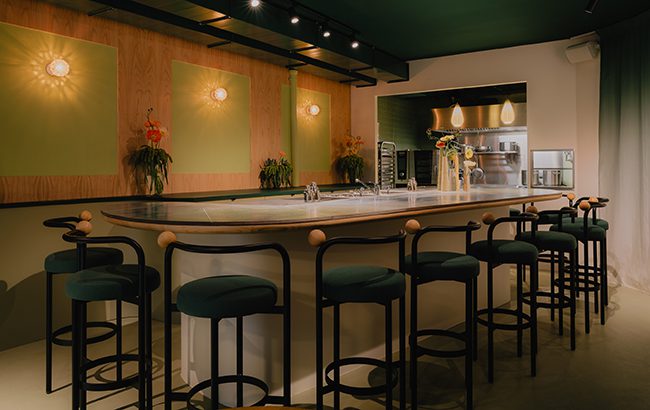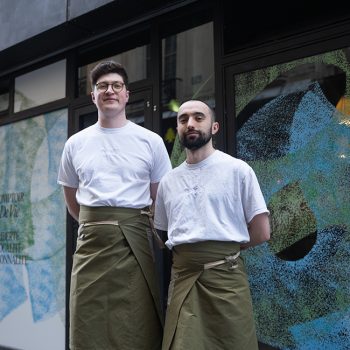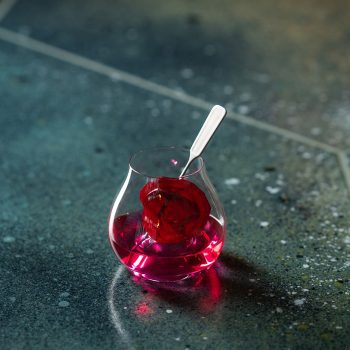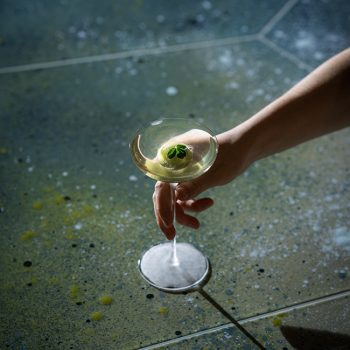Alex Francis and Barney O’Kane on bringing De Vie to life
By Lauren BowesThe doors of Comptoir De Vie finally opened in Paris this month after a year of anticipation, bringing a radical rethink of cocktail bar sustainability.

The dual concept is split between Comptoir de Vie, a ‘hyper-seasonal’ restaurant, and Bar de Vie, a more laidback cocktail bar with small plates. While Comptoir opened on 7 March, Bar will follow later this year. The project has been spearheaded by Little Red Door alumni Alex Francis and Barney O’Kane, along with chef Adam Purcell.
“A lot of the aspirations and ideas for the bar come off the back of mine and Alex’s five years together at Little Red Door,” explains O’Kane. “When we were thinking about what we’d want the bar to be, we had natural things we wanted to carry over – such as working solely with independent French producers, working seasonally, working locally – but so much of our time at Little Red Door was consumed by trying to put changes into an already existing system.”

“When we started with De Vie, it felt like we very much had a blank canvas to address those things from the beginning,” adds Francis.
Many will see sticking only to local, seasonal produce as a restriction, but for O’Kane and Francis, their ethos is an opportunity. “Working hyper-seasonally and incredibly locally is exciting, both creatively, but also from a guest point of view,” explains Francis. “It allows things to constantly change.”
Comptoir is “the closest we can imagine an authentically seasonal offering in food and drink – so, produce changes day by day, week by week,” explains Francis, while Bar de Vie sticks to a “more traditional idea of seasonality”, which allows the team to work efficiently. “Working on a small scale for our drinks would be great, but it means you have slightly higher amounts of waste and inefficiencies, and that would be reflected in the price,” admits Francis.
Keeping pricing accessible at Bar de Vie is another key part of its ethos. He continues: “We love supporting local producers and working with the very finest produce, but as everyone knows, it’s hard to make a margin, making it inaccessible to even people the same age as Barney and I.
“When we first started at Little Red Door, we were making drinks for people like ourselves. But by the time we finished there, we were doing collaborations in venues we could never afford to go into.
“On the one hand, they were lovely places to work, but it was very bizarre occupying a space you don’t feel natural in. We wanted to find a way of channelling our ethos and our way of working into an offering that is accessible to our friends and our peers, and also inspiring to other bartenders.”
Giving ice the cold shoulder
One key element the duo were keen to bring to the new bar that wasn’t possible at Little Red Door was a complete banning of ice. “It’s wildly unsustainable, whether you’re talking about clear ice or just machine ice,” explains Francis. “Commercial ice makers are horribly inefficient when it comes to water management – they use something like 10 litres of water for every litre of ice created.”
Getting rid of ice isn’t a new idea, he admits, pointing to Ryan Chetiyawardana’s original bar, White Lyan, which opened in 2013. Deciding to eliminate it completely was “one of those things where you pull at a thread and then, all of a sudden, the whole thing’s undone.” The transportation and packaging involved in clear ice meant that was out, and a machine was out of the question – so, why not no ice at all?

All drinks at Bar de Vie are prebatched and prediluted – something hardly revolutionary for the industry. “Personally, I haven’t worked in a bar for more than 10 years where almost every single ingredient isn’t batched,” says Francis. The only difference is that other bars dilute their prebatched ingredients by shaking or stirring with ice, while Bar de Vie dilutes them with water and stores in the fridge.
While clear ice has become de rigueur in bars these days, the duo have a theory that most consumers are unaware of why it’s used and what it costs. They point to a New York bar they visited that offered Happy Hour cocktails for US$15, or with a clear block of ice for US$20, as well as a recent TikTok trend of people lifting the ice out of their glasses and asking where ‘the rest’ of their drink is.
Francis believes this divide between what bars think is important and what consumers want is growing: “There seem to be two categories of bar now: the five-star dive bar, with a rejection of modern ideas, which are about doing fun drinks quickly. Then there are the 50 Best-aspiring modern cocktail bars, which seem to be moving further and further away from the majority of consumers, where guests just stare at drinks and go: ‘Yeah, it tastes nice but I have no idea what this is. I don’t understand what’s going on.’”
A focus on France
De Vie, of course, hopes to be something else. “We don’t really subscribe to that North American idea of every bar needs to be able to do the exact same things, where you can walk in off the street and have whatever you want. We’re incredibly proud and passionate about what we do, and we don’t apologise for what we’re not,” Francis says.
That means ordering an off-menu Margarita in winter will be a no-no – there’ll be no lime juice, no Tequila, and no ice to shake it on. The team are happy to recommend other venues, such as Candelaria for agave drinks and 1802 for Daiquiris. “We love those places,” says Francis. “Our choice as a venue not to do those things isn’t a critique of other places that do them. It’s just not what we want to spend our time doing.”

Other things not in the French larder include coffee and chocolate – but Francis isn’t too fussed, saying that chicory can add coffee notes where needed. Replica chocolates exist, but the flavour can be recreated through other means – such as mixing vanilla and grapefruit juice to create a profile similar to white chocolate.
“The way we approach making drinks though – unless a guest is asking for something like that – we’re never going to be looking for it. We’re never saying: ‘Oh, we want to add the flavour of chocolate here.’ We start from the produce, and the produce dictates to us where our drinks go.”
The produce is so key to the concept that it even drove the location. Francis explains: “People ask why we didn’t move back to London, why we didn’t go to Dublin. We couldn’t do what we do outside of France, or at least not as well as we think we can now.
“There aren’t many places in the world that have fully established whisky, Cognac, Calvados, Champagne and wine markets. But, most importantly, agriculturally, there are very few places in the world that can grow rice in the southeast, buckwheat in the southwest, and can grow apples. France has this insane breadth and depth of agricultural produce that allows us to do this.”
Related news
Bumbu sales soar in UK on-trade
